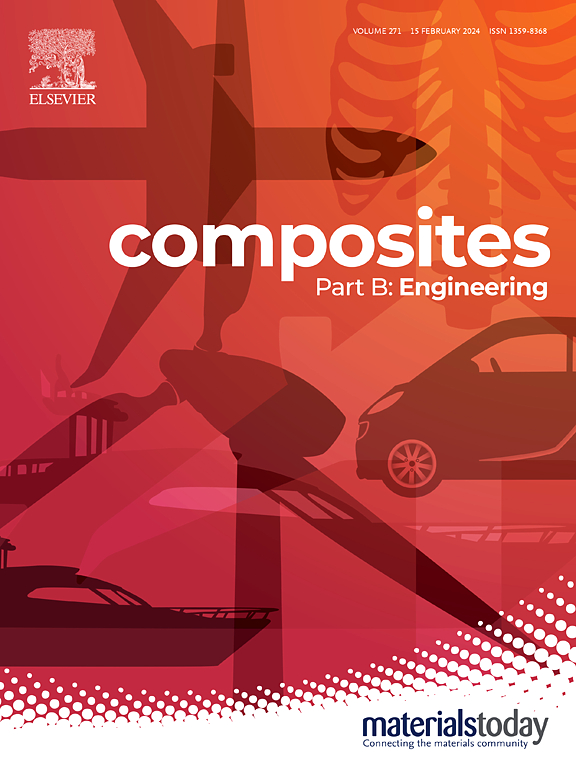Multiscale topology optimization and 3D printing of continuous carbon fiber reinforced composites lattice structure
IF 12.7
1区 材料科学
Q1 ENGINEERING, MULTIDISCIPLINARY
引用次数: 0
Abstract
3D printing of continuous carbon fiber reinforced composites (CCFRCs) enables the production of multiscale lattice structures, characterized by macro- and mesostructures defined by fiber trajectories. In this paper, a multiscale topology optimization and 3D printing framework for CCFRCs lattice structures was developed, where both macro-scale topological morphology and meso-scale unit cell orientation were simultaneous optimized, and was implemented through a well-connected 3D printing path. Benchmark structures, including the cantilever beam and the Messerschmitt-Bölkow-Blohm (MBB) beam, were optimized. The results demonstrated that structural stiffness and peak load were improved by 182.94 % and 57.96 %, respectively, compared to traditional lattice structures with uniformly distributed periodic unit cells, and by 143.72 % and 20.71 %, respectively, compared to topological lattice structures with fixed unit cells, highlighting effectiveness of the proposed method. Furthermore, an unmanned aerial vehicle (UAV) arm was designed using the proposed method and experimentally validated under operating load conditions. Based on this, a proof-of-concept UAV frame was developed and 3D printed, demonstrating the advantages of lightweight design and efficient manufacturing. Multiscale topology optimization and 3D printing could promote the potential of CCFRCs lattice structures, which hold enormous prospects in aviation, aerospace, and other fields.
连续碳纤维增强复合材料晶格结构的多尺度拓扑优化与3D打印
连续碳纤维增强复合材料(CCFRCs)的3D打印能够生产多尺度晶格结构,其特征是由纤维轨迹定义的宏观和细观结构。本文开发了CCFRCs晶格结构的多尺度拓扑优化和3D打印框架,其中宏观尺度拓扑形态和中观尺度单元胞取向同时优化,并通过连接良好的3D打印路径实现。对包括悬臂梁和Messerschmitt-Bölkow-Blohm (MBB)梁在内的基准结构进行了优化。结果表明,与具有均匀分布周期单元格的传统晶格结构相比,结构刚度和峰值荷载分别提高了182.94%和57.96%,与具有固定单元格的拓扑晶格结构相比,结构刚度和峰值荷载分别提高了143.72%和20.71%,表明了该方法的有效性。在此基础上,设计了一种无人机臂架,并在运行载荷条件下进行了实验验证。在此基础上,开发并3D打印了概念验证型无人机框架,展示了轻量化设计和高效制造的优势。多尺度拓扑优化和3D打印技术可以提升CCFRCs晶格结构的潜力,在航空航天等领域具有广阔的应用前景。
本文章由计算机程序翻译,如有差异,请以英文原文为准。
求助全文
约1分钟内获得全文
求助全文
来源期刊

Composites Part B: Engineering
工程技术-材料科学:复合
CiteScore
24.40
自引率
11.50%
发文量
784
审稿时长
21 days
期刊介绍:
Composites Part B: Engineering is a journal that publishes impactful research of high quality on composite materials. This research is supported by fundamental mechanics and materials science and engineering approaches. The targeted research can cover a wide range of length scales, ranging from nano to micro and meso, and even to the full product and structure level. The journal specifically focuses on engineering applications that involve high performance composites. These applications can range from low volume and high cost to high volume and low cost composite development.
The main goal of the journal is to provide a platform for the prompt publication of original and high quality research. The emphasis is on design, development, modeling, validation, and manufacturing of engineering details and concepts. The journal welcomes both basic research papers and proposals for review articles. Authors are encouraged to address challenges across various application areas. These areas include, but are not limited to, aerospace, automotive, and other surface transportation. The journal also covers energy-related applications, with a focus on renewable energy. Other application areas include infrastructure, off-shore and maritime projects, health care technology, and recreational products.
 求助内容:
求助内容: 应助结果提醒方式:
应助结果提醒方式:


